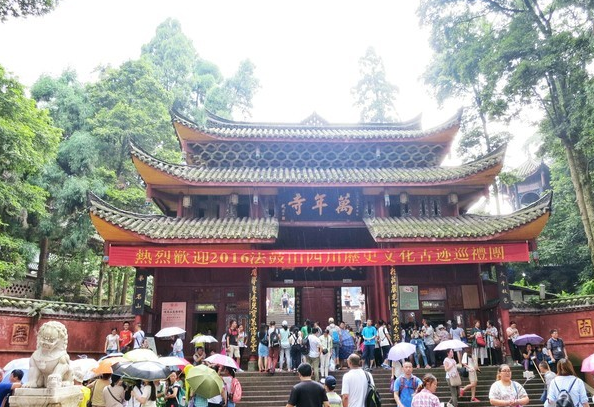24 Hours Hotline: +8613735411378
Email:[email protected]
24 Hours Hotline: +8613735411378
Email:[email protected]

Overview
Wannian Temple is a Buddhist temple located at the foot of Camel Mountain Range of Mount Emei, in Emeishan City, Sichuan, China. It is one of the six earlist Buddhist temples on Mount Emei. The temple is situated at the foot of Camel Mountain Range, facing the Daping Temple, Niuxin Temple, Shisun Summit and Bomeng Summit (???) in the front. Wannian Temple is known not only for the bronze statue of Samantabhadra, but also for the Beamless Brick Hall.
History & Background
East Jin and Tang dynasties
Wannian Temple was first established by Huichi (??) in the East Jin dynasty (317–420), it was called "Puxian Temple" originally and changed to "Baishui Temple" when it was reconstructed by Huitong (??) in 876 in the 3rd year of Qianfu period of the Tang dynasty (618–907).[1] In the Kaiyuan period (713–741) of Emperor Xuanzong, poet Li Bai stayed in the Pilu Hall (???) and wrote many poems while listening to the music played by Guangjun.
Northern Song dynasty
In 980, in the reign of Emperor Taizong in the Northern Song dynasty (960–1127), Maozhen (??) restored the temple and casted a bronze statue of Samantabhadra in the temple. The temple was renamed "Baishui Puxian Temple" (?????; "White Water Samantabhadra Temple").
Ming dynasty
In 1535, in the Jiajing era of the Ming dynasty (1368–1644), Biechuan (??) made three statues of Buddha in the temple. Destroyed by a large fire in the Wanli period (1573–1620), it was rebuilt by monks under the order of Wanli Emperor in 1601. And the Beamless Brick Hall (????) was added to the temple with a plaque inscribed by Wanli Emperor with Chinese characters of "Shengshou Wannian Temple" .
Qing dynasty
In the fall when Mount Emei enjoys the best weather, the mount is decorated with colorful maple and ginkgo trees refleced on the green water lake. This poetic scenery was called "White Water in the Wind of Fall" (????) and acclaimed one of the ten best sceneries in Mount Emei by Qing dynasty scholar Tan Zhongyue (???).
Republic of China
In 1946, the temple was completely destroyed with only the Beamless Brick Hall remaining.
People's Republic of China
After the founding of the Communist State in 1954, the local government rebuilt the temple.
In the 1950s and 1960s, Zhu De, Chen Yi and He Long visited the temple successively. On July 8, 1980, Deng Xiaoping visited the temple and lived one night. In 1983, Wannian Temple was designated as a National Key Buddhist Temple in Han Chinese Area by the State Council of China. In 1986, the Shanmen, Hall of Maitreya, Hall of Pilu and Bore Hall (???) were added to the temple. And the Drum Tower, Bell Tower and corridors were erected in 1991.

Architecture
Wannian Temple faces the west with the Shanmen, Hall of Maitreya, Beamless Brick Hall, Majestic Hall (????), Mahavira Hall, and the Buddhist Texts Library along the central axis of the complex.
Beanless Brick Hall
The Beanless Brick Hall was built in 1600 by Wanli Emperor to congratulate the birthday of his mother. It is 17.12-metre (56.2 ft) high, 15.79-metre (51.8 ft) wide and 16.06-metre (52.7 ft) long. Inspired by techniques and styles of India and Myanmar with not a single piece of wood was used. Walls of the hall are decorated with patterns of wood-like structures like circular arches, vertical columns, window lattices and etc. On the dome there are five white pagodas and statues of four auspicious animals. With the ancient style, the walls of dome were carved with small statues of Buddha, which were called "Thousand Buddha Worshiping Samantabhadra" (?????).
A bronze statue of Samantabhadra riding a white elephant is placed under the dome. It is 7.35-metre (24.1 ft) high and weight 62,000-metre (203,000 ft). The statue was cast in 980, during the 5th year of Taiping Xingguo period of the Northern Song dynasty (960–1127). Sitting on the lotus throne, Samantabhadra wears a golden crown on the head and holds a Ruyi, his mount is also standing on four lotus platforms.
Xingyuan Hall
Behind the Beanless Brick Hall is the Xingyuan Hall (???) housing three national treasures: the Wanli Golden Seal (????), tooth relic of the Buddha (??) and palm leaf manuscript (???). The Wanli Golden Seal was cast in 160 and presented by Empress Cixiaoxian. According to the Annals of Mount Emei, the palm leaf manuscript was presented by the King of Myanmar in the mid-16th century, namely the Jiajing period (1522–1566) of the Ming dynasty (1368–1644).

Information
Location:foothill of the Guanxinling, Emeishan Scenic Area, Emeishan City, Leshan City, Sichuan Province
Opening Time: 07:00-18:00
Ticket Price: CNY10 per person
Time for visiting: 1-3 hours
How to get there:
You can sightseeing bus from Baoguo Temple bus station to Wannian Temple parking lot, it costs CNY10; Or you can take Wannian Cable car from Wannian Temple parking lot. (The operation hour is 6:40-18:00)
Wechat: Chinaprivatetour
24 Hours Hotline:
+8613735411378
(Your Privacy is Protected)
1 to 1 tailor-made service from our professional travel advisors for the most sophisticated
Constantly excellent reviews for attraction, hotel and service Competitive price
Local experts provide quality tours Best selected knowledgeable local guides Authentic local restaurants
7*24 hours available to create you a worry-free tour. No Hidden Fees and absolutely no pressure to buy. Secured







